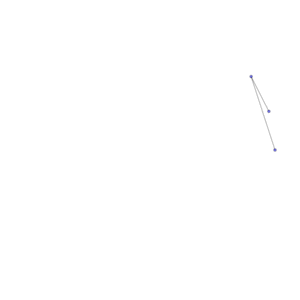ROLL [1] is a tool for fast generation of gigantic Barabasi-Albert graphs. Barabasi-Albert is a model for generating synthetic graphs that exhibit the properties of large real-world networks, such as the World-Wide-Web, Citation networks and social networks. Networks generated by the Barabasi-Albert model exhibit the scale-free property, i.e. their degree distribution follows a power-law.
The following image illustrates how a BA-graph is incrementally generated. The BA model starts with an initial network with size m_0. Each new node is added to m existing nodes with probabilities proportional to the degree of each existing node. In other words, the more connections a node has, the more frequently the node will receive new connection.
This package contains various implementations for the Barabasi-Albert model, as discussed [1]. The difference between these implementations is in their algorithmic approach for roulette wheel selection from a dynamic distribution. These algorithms are listed below:
- Simple roulette wheel selection
- Stochastic Acceptance [2]
- Roll-Bucket [1]
- Roll-Tree [1]
The ROLL roulette wheel methods, specifically the ROLL-tree algorithm, are specifically designed to enable fast generation of scale-free networks with the Barabasi-Albert model. Details are explained in the ROLL paper [1]
-
Clone ROLL:
git clone https://github.com/alihadian/ROLL.git -
ROLL is using Maven for building the package, ensure maven is installed on the system. To build the package, type:
cd ROLL mvn package -
Execute the jar file:
java -jar target/ROLL-0.3-SNAPSHOT-jar-with-dependencies.jar -n 1000 [other params]
-
-n number of nodes
-
-m number of edges per node, i.e. the average degree (default = 2)
-
-o output file name (default: no output)
-
-s sampling mode (simple, roll-bucket, roll-tree, SA)
-
-m0 number of initial nodes. Note that m0 >= m (default: =m)
-
-d only for ROLL-tree: path to save the degree distribution file.
The resulting graph is saved in a text file. Also, the performance measures (execution speed and time taken by various components) is printed in the standard output.
You should explicitly define the output file (using -o switch), or otherwise no output file is created. The output file contains the edge list of the graph, where each line contains a single edge: source_node_id target_node_id (tab-delimtited). for example:
0 1 0 2 1 2 ...
Since this package is primarily used for performance comparison, the performance measures are printed in the standard output:
SamplingMode NumNodes m NumEdges NumComparisons \\
TotalTime SamplingTime MaintenanceTime Num_buckets \\
Tree-code-word-length Tree-optimal-huffman-code-word-length \\
Total-buckets-inserted* Total-buckets-removed*
Notes:
-
SamplingTimeis the time required for "selecting the next item", excluding the time of writing edge list to file and the time of maintaining the data structure after sampling -
MaintenanceTimeis the time for maintaining the data structure. For example, in ROLL-tree, the MaintenanceTime is the time taken to add new buckets to the tree (considering the balancing procedure) or remove a bucket from the tree. -
NumComparisonsillustrates how many comparisons are performed by each of the algorithms to select an item from the roulette wheel. For example, in the simple roulette wheel algorithm, NumComparisons is the number of items traversed to find the target node corresponding to the random number. See [1] for detailed explanation. -
Num_bucketsis the number of buckets in ROLL-tree and ROLL-bucket. -
Tree-code-word-lengthandTree-optimal-huffman-code-word-lengthare the actual and optimal code word lengths of ROLL-tree. -
*
Total-buckets-insertedandTotal-buckets-removedillustrate how many times a bucket is inserted/deleted into the ROLL-tree. These two measures are only printed for ROLL-tree and its variant ROll-tree-sorted.
The source code contains three main folders:
-
org.hadian.bagraph.generators.BAGraphGenerator.java: ُThis is the main class that generates Barabasi-Albert graphs. It can use various roulette wheel algorithms, that is chosen by user as a program argument. -
org.hadian.bagraph.roulettes.*: This package contains various roulette wheel data structures that can be used for generating BA graphs. All data structures in this package implementorg.hadian.bagraph.roulettes.NodesList, which offers two simple operations (functions): "initialize graph", and "add one node to the graph". -
org.hadian.bagraph.util.XOrShiftRandomGenerator.java: An implementation of XOrShift, a fast random number generator. An interesting fact about ROLL-tree (and to some extent, ROLL-bucket) is that the selection probabilities of items (buckets, or right/left subtrees) is not very skew, so that a less-accurate random generator performs well for these methods.
[1] A. Hadian, S. Nobari, B. Minaei-Bidgoli, and Q. Qu, ROLL: Fast in-memory generation of gigantic scale-free networks. In Proceedings of the ACM SIGMOD International Conference on Management of Data, 2016.
[2] A. Lipowski and D. Lipowska. Roulette-wheel selection via stochastic acceptance. Physica A, 391(6):2193–2196, 2012.
Licensed under the Apache License, Version 2.0. This repository is adapted with ACM reproducibility. Owner of artifact grants ACM permission to serve the artifact to users of the ACM Digital Library.
If you find this package useful, we kindly ask you to cite the paper [1]. Here is the BibTex record:
@inproceedings{hadian2016roll,
author = {Hadian, Ali and Nobari, Sadegh and Minaei-Bidgoli, Behrooz and Qu, Qiang},
title = {ROLL: Fast In-Memory Generation of Gigantic Scale-free Networks},
booktitle = {Proceedings of the 2016 International Conference on Management of Data},
series = {SIGMOD '16},
year = {2016},
isbn = {978-1-4503-3531-7},
location = {San Francisco, California, USA},
pages = {1829--1842},
numpages = {14},
url = {http://doi.acm.org/10.1145/2882903.2882964},
doi = {10.1145/2882903.2882964},
acmid = {2882964},
publisher = {ACM},
address = {New York, NY, USA},
}
For further inquiries, feel free to contact me.
